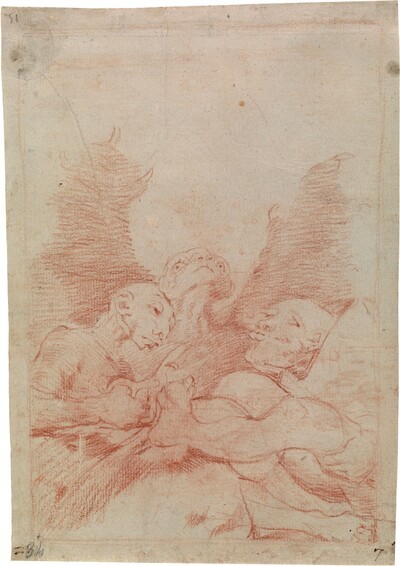- Cronología
- Ca. 1797 - 1799
- Dimensiones
- 214 x 149 mm
- Técnica y soporte
- Aguafuerte, aguatinta bruñida y buril
- Reconocimiento de la autoría de Goya
- Undisputed work
- Ficha: realización/revisión
- 21 Dec 2010 / 29 May 2024
- Inventario
- 225
Se repulen. (at the bottom)
51. (in the upper right-hand corner)
See Francisco de Goya y Lucientes, Painter.
A preparatory drawing of this engraving has survived.
A winged monster, standing frontally in the centre of the composition and slightly shifted towards the background, seems to shelter two other figures in its wings. They are two deformed beings, one of whom uses a pair of large scissors to cut the toenails of the other.
In this print Goya used two tones of aquatint and left a few reserves of varnish. He used the burnisher to capture the clouds in the sky, as well as to create the mid-tones of the figures.
The manuscript in the National Library provides a fairly clear explanation for this print: "The employees who rob the state help and support each other. The Chief of them often raises his neck and shadows them with his monstrous wings".
The use of the term "polish" has a double meaning here: on the one hand it alludes to the grooming of the monstrous beings in the print, but on the other it refers to theft. In this way the artist makes a veiled criticism of the authorities, especially the ministers, who cover up the theft of public money. They would be, in this case, the winged figure that covers the other two figures with its wings and looks up at the sky, as if it were not seeing what is happening.
The plate is in rather poor condition (National Chalcography, no. 222).
-
El arte de GoyaMuseo de Arte Occidental de TokioTokyo1971from 16th 1971 to January 23th 1972. Exhibited also at the Kyoto Municipal Museum of Art, January 29th to March 15th 1972.cat. 76
-
Goya. Das Zeitalter der Revolucionen. Kunst um 1800 (1980 – 1981)Hamburger KunsthalleHamburg1980cat. 51
-
Goya. La década de Los CaprichosMadrid1992organized by Real Academia de Bellas Artes de San Fernando sponsored by Fundación Central Hispano, Madrid, consultant editor Nigel Glendinnig. From October 26th 1992 to January 10th 1993cat. 167
-
GoyaNationalmuseumStockholm1994consultant editors Juan J. Luna and Görel Cavalli-Björkman. From October 7th 1994 to January 8th 1995cat. 67
-
Francisco de GoyaMuseo d'Arte ModernaLugano1996exhibition celebrated from September 22nd to November 17th.cat. 51, p.78
-
Ydioma universal: Goya en la Biblioteca NacionalBiblioteca NacionalMadrid1996from September 19th to December 15th 1996cat. 141
-
Francisco Goya. Sein leben im spiegel der graphik. Fuendetodos 1746-1828 Bordeaux. 1746-1996Galerie KornfeldBern1996from November 21st 1996 to January 1997cat. 57
-
Goya e la tradizione italianaFondazione Magnani RoccaMamiano di Traversetolo (Parma)2006consultant editors Fred Licht and Simona Tosini Pizzetti. From September 9th to December 3th 2006cat. 51, p.158
-
Goya. Opera graficaPinacoteca del Castello di San GiorgioLegnano2006exhibition celebrated from December 16th 2006 to April 1st 2007p.37
-
Goya e ItaliaMuseo de ZaragozaZaragoza2008organized by the Fundación Goya en Aragóna, consultant editor Joan Sureda Pons. From June 1st to September 15th 2008cat. 334
-
Goya et la modernitéPinacothèque de ParisParís2013from October 11st 2013 to March 16th 2014cat. 197
-
Goya engravings and lithographs, vol. I y II.OxfordBruno Cassirer1964p.124, cat. 86
-
Vie et ouvre de Francisco de GoyaParísOffice du livre1970p.182, cat. 553
-
Goya, la década de los caprichos: dibujos y aguafuertesMadridReal Academia de Bellas Artes de San Fernando1992pp.271-273, cat. 166-167
-
Catálogo de las estampas de Goya en la Biblioteca NacionalMadridMinisterio de Educación y Cultura, Biblioteca Nacional1996p.100, cat. 139
-
El libro de los caprichos: dos siglos de interpretaciones (1799-1999). Catálogo de los dibujos, pruebas de estado, láminas de cobre y estampas de la primera ediciónMadridMuseo Nacional del Prado1999pp.274-277
-
ParísPinacoteca de París2013p. 263
-
Goya. In the Norton Simon MuseumPasadenaNorton Simon Museum2016pp. 42-75

